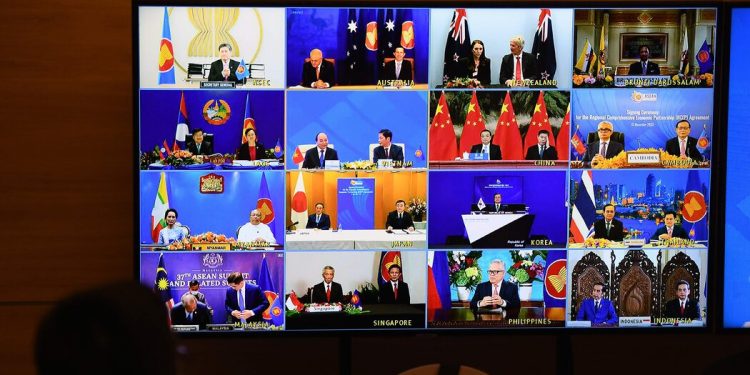The formation of the world’s biggest free trade bloc – the Regional Comprehensive Economic Partnership (RCEP) – by 15 Asia-Pacific economies, minus India, on 15 November comes close on the heels of the Shanghai Cooperation Organisation Summit (SCO) last week. Prime Minister Narendra Modi had, in that online summit, belligerently spelt out India’s stand in the backdrop of the faceoff with China in Ladakh. He stated that India will not accept anyone’s territorial interference in the name of facilitating trade and commerce. PM Modi, in his predictable style, had refrained from spelling out China’s name even at SCO.
Chinese President Xi Jinping didn’t directly respond to Modi’s veiled reference to his country’s territorial ambition, but asserted “history has proven and will continue to prove that good-neighbourliness will prevail over a bigger-than thy-neighbour approach, mutually beneficial cooperation will replace zero-sum game and multilateralism will beat unilateralism.”
As if to din his message into India’s ears, Xi quoted a Chinese proverb – “Men of insight see the trend, while men of wisdom ride it” and then China went on to pilot Sunday’s RCEP deal signed on the sidelines of an online Association of Southeast Asian Nations (ASEAN) summit. The 10-nation ASEAN leaders grappled with the problem of tackling plans for a post-pandemic economic recovery in a region where rivalry between the USA and China is rising.
Leaders of the RCEP countries, in a symbolic move, took turns standing behind their trade ministers who, one by one, signed copies of the agreement. The Prime Minister of Vietnam, Nguen Xuan Phuc, said: “RCEP will soon be ratified by the signatory countries and take effect, contributing to the post-pandemic economic recovery.”
The China-backed initiative of forming the world’s largest economic bloc is a significant development as it accounts for over 30 per cent of the world’s economy ($142 trillion) and reaches 2.2 billion consumers. It is intended to cement China’s position more firmly as an economic partner with Southeast Asia, Japan and Korea and putting the world’s second largest economy in a better position to shape the region’s trade rules. It will also be noteworthy how India fares in this scheme of things with Donald Trump ousted from power. The Modi government publicly leaned on Trump a good deal which may prove detrimental to India’s future.
In another significant diplomatic posturing, Xi in his SCO summit deliberately mentioned his country’s controversial Belt and Road Initiative. This project has become a thorn in India’s flesh, complicating further Indo-Pak-Chinese relations. Xi said: “We should forge greater synergy of the Belt and Road Initiative with national development strategies as well as regional cooperation initiatives such as the Eurasian Economic Union. We should enhance connectivity and further integrate our industrial, supply and value chains for unimpeded economic circulation in the region, facilitate reopening of economic activities through the ‘fast track’ that steps up mobility of people and the ‘green lane’ that quickens the flow of goods, foster an open, fair and non-discriminatory business environment for each other’s companies, and expand mutual investment among us.”
Earlier, Modi had stated at the summit: “India believes that to enhance connectivity it is important that we move forward while respecting one another’s sovereignty and territorial integrity.”
Modi and Xi shared the virtual platform for the first time since hostility broke out between India and China over the Ladakh incident. Modi’s statement is also a veiled reference to China’s backing of the massive 3,000-km-long infrastructure project – China-Pakistan Economic Corridor (CPEC), which connects Kashgar in western China with Gwadar port in Pakistan and passes through Pakistan-occupied Kashmir. India has, from the outset, protested China’s CPEC push as the corridor passes through PoK.
Foreign Secretary Harsh Vardhan Shringla’s veiled warning at the recent programme in London that the world should guard against the real intent of China’s Belt and Road Initiative was a response to Pakistan Prime Minister Imran Khan’s announcement that his government would give Gilgit-Baltistan region ‘provisional provincial status.’ The new arrangement of the Pakistan government has serious strategic, economic and geopolitical ramifications with China emerging as the author of a new global order. China’s silence on Imran Khan’s announcement is in sharp contrast to the shrill noise it made when the Indian government redrew the contours of the state of Jammu and Kashmir after abrogation of Article 370. This is not simply to back its ally, but also to ensure that the construction of the CPEC across the Gilgit-Baltistan region picks up its rhythm after being halted for some time. Gilgit-Baltistan is the northernmost territory administered by Pakistan, providing the country’s only territorial frontier – a land route – with China, where it meets the Xinjiang Autonomous Region.
These events and utterances demonstrate an utter failure of India’s diplomatic thrusts of the recent past. For example, the Malabar military exercise held last month under the QUAD banner compromising India, USA, Japan and Australia now stands without three legs. On one hand, Japan and Australia have become signatories of RCEP and will obviously avoid any anti China military posturing in the future. On the other, the change in the US administration will also change the new government’s attitude towards India. The direct support of PM Modi to outgoing President Donald Trump during his election campaign would, most likely, prove to be an expensive diplomatic debacle that India will be forced to suffer through for a long time to come.






































